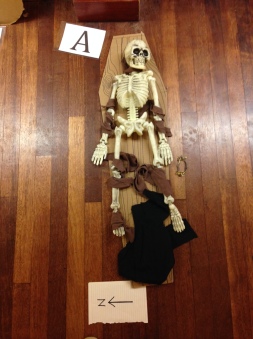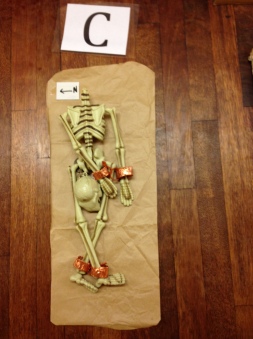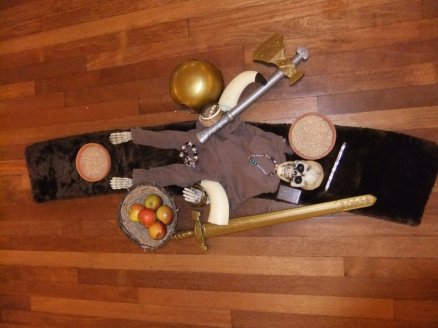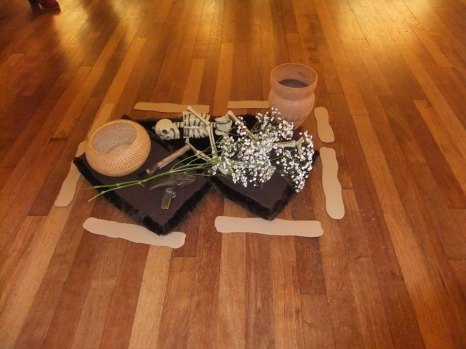In October, with one eye on the approach of Halloween, we used our session to explore burials, bodies and bones. Just what can burials tell us about the individuals buried, about the people who buried them and the society they lived in? At the start of the session we had lots of questions. Could we find clues to tell us… who they were?…Where they lived?… How important or wealthy they were?… How old they were?…What they believed?… How and when they died?…What they meant to the people that buried them? The answer was Yes, but how could we find it out? What survives at a burial site after 1000 years? What about 3000 years or even just 200 years? And, just how has burial practice changed over time?
We started with our Burial Detective Game – the leaders has recreated burials from 4 different time periods each giving clues as to the time period that they came from, about the individual that was buried, what they believed and what might have happened to them. We split into groups and examined each burial in turn, looking carefully at the position of the skeleton, the shape and type of grave and the gravegoods included in the grave. We recorded our findings to compare notes at the end, and to put together our archaeological interpretation of what the remains represented.
We decided collectively that the graves represented – A Victorian Lady buried with love and respect; a Roman prisoner/gladiator buried in a hurry; a wealthy and important Iron Age woman and Stone Age burial chamber, potentially with the partial remains of more than one individual. Can you tell which one is which? One of them is a recreation of a famous burial found in our very own National Park at Penywyrlod Chambered Tomb near Talgarth where the oldest musical instrument in Wales was found; the others drew inspiration from other famous burials found by archaeologists around the UK.
Next we had a go at creating some graves and burials for ourselves, in order to understand burial practices, to see what might remain in the archaeological record, and just how much information is lost. We started with a Viking burial, taking inspiration from boat burials found in the West of the UK and Scandinavia. We did our best to find the most Viking looking gravegoods that we could. We fast forwarded 1000 years to become archaeologists and removed anything from the burial that we didn’t think would survive.
We then went further back in time to the Bronze Age and re-created a burial in a cist under a round cairn. Here we took inspiration from the excavation of the Bronze Age round cairn that tops Fan Foel in the Carmarthen Fans in the Brecon Beacons National Park and the excavation of the Whitehorse Hill Burial in Dartmoor National Park. Again we fast forwarded in time and took away anything that wouldn’t usually survive in the archaeological record to see what we were left with and how it related to the process of creating the burial – we realised just how much evidence is lost!
We finished our session by creating our own modern day equivalent of a rich archaeological burial with lots of gravegoods. A willing volunteer was ‘buried’ along with a whole host of modern objects – fizzy pop and sweets so they had something to eat; a variety of things to keep them entertained – books, cds, video games, dvds, a tablet computer and of course archaeology magazines(!); a fleece to keep them warm; photos of their loved ones and pets; a cuddly toy, and of course…a fez…because in the words of Dr Who ‘Fez’s are cool!’
We realised that with so many objects made of man made materials – polyester, plastic, and also quite a lot of metal, if we returned in 1000 years we would probably still find the remains of quite a lot more of the objects that we did in the Bronze Age or Viking burials.
We all had a great time, learning lot and having fun, and the session was over all too soon.








